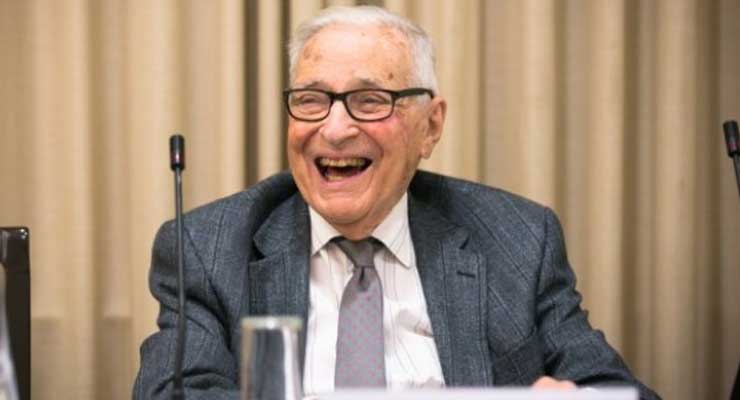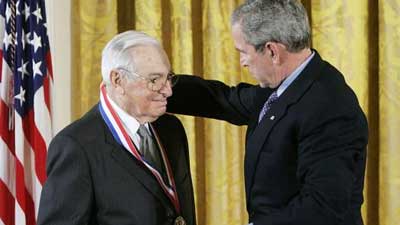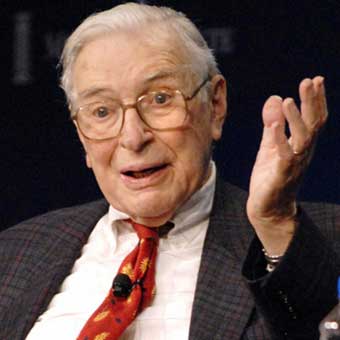
Dr. Kenneth Arrow, the youngest person to earn a Nobel Prize in economics, just passed at the age of 95 in his Palo Alto home near Stanford University, where he remained a professor emeritus. He made numerous academic contributions. These achievements got him the von Neumann Theory Prize as well as a National Medal of Science. Chief among his contributions, however, was his Impossibility Theorem on voting theory. This is a tribute to Dr. Arrow while trying to help the general public understand his most famous theorem.
 Dr. Arrow’s interview with Nobel.org showed his true delight in learning. By all accounts, his intellect was wide-ranging and sharp. He was generous with his time and never self-important. He graduated high school early. Due to finances, he went to a free city college in New York.
Dr. Arrow’s interview with Nobel.org showed his true delight in learning. By all accounts, his intellect was wide-ranging and sharp. He was generous with his time and never self-important. He graduated high school early. Due to finances, he went to a free city college in New York.
There, he took to statistics and probability, deciding to major in math. He then did his graduate work at Columbia. During the Ph.D. portion, he worked at the Cowles Commission for Research in Economics at the University of Chicago and at the RAND Corporation. It was at the RAND Corporation where he developed the famous Impossibility Theorem, which became his doctoral dissertation.
So what did this theorem say?
He proved that there is no voting method for picking a single winner that can always satisfy all of the following criteria when there are more than two candidates (note that some lists show fewer criteria for simplicity):
- Voters can rank one or more candidates in preference order but cannot give any information as to the relative strength of their various preferences. (In fact, he required that voters rank all candidates, but allowed for systems which ignore all but the first rank such as plurality voting.)
- There is no single person who can unilaterally determine the outcome. (There can’t be a dictator.)
- Voters get to rank their preferences however they wish.
- If every voter prefers one candidate over another particular candidate, then the lesser preferred candidate cannot win. (Unanimity must hold at the group level.)
- The outcome ordering the candidates must be consistent. For example, if candidate A beats candidate B, and candidate B beats candidate C, then candidate A must also beat candidate C. Think of rock-paper-scissors here with each item being a candidate that will lose to at least one other option. Dr. Arrow thought a voting method should avoid that kind of outcome. (The outcome must be transitive.)
- An alternative candidate unable to win must not change the winner of the election by their mere presence. (The method must remain independent of irrelevant alternatives.)
So does this mean that all voting methods are equally terrible? Should you abandon hope for improvements on how we vote?
No. Arrow’s theorem implies none of that pessimism. His theorem just says that no ranking method can always meet all these criteria. That’s all. There’s a way out from where we are now.
Again, the theorem’s focus is on ranking methods, which includes the choose-one plurality voting method we’re used to. Arrow’s theorem does not apply to non-ranking methods like approval voting and score voting (cardinal methods). We know this from the theorem description itself and because Dr. Arrow personally told us when we interviewed him back in 2012:
“And in my theorem I’m assuming that the information is a ranking. Each voter can say of any two candidates, I prefer this one to this one.”
Does this mean that all non-ranking methods are perfect? No, it doesn’t.
Inspired by Arrow, others proved similar theorems which do apply to non-ranking methods. For instance, the Gibbard-Satterthwaite theorem shows that any voting system gives an advantage to strategic voters in some circumstances. But still, there exist non-ranking methods which—though not perfect—are relatively robust, both in terms of Arrow’s criteria and in terms of voting strategy.
That is, instead of passing many criteria perfectly but failing one of them badly, certain non-ranking methods come close to passing all of the criteria. And when these voting methods do fail a criterion, they tend not to deliver such catastrophic results.
Arrow’s theorem is often casually tossed in at the end of general 100-level college math courses. It’s typically framed in such a way to have the reader believe that all is lost in searching for better voting methods. But Dr. Arrow made no such conclusion. This is what he said in his interview with us:
“I think the answer is you have to ask, in effect, which ones get closest to this combination? And we have to then begin to look at what actual votes are. The real way we do this is to apply some rule and to take elections and apply different methods and see what violates these conditions as little as possible. Remember all we’re saying is there could be a [violation]. We’re not saying you’re always getting a violation of these rules.”
Dr. Arrow did not see all voting methods as equals. For instance, he didn’t like plurality voting, our ubiquitous choose-one voting method. He explained how it propagates a two-party system:
“I think plurality voting leads to very unsatisfactory solutions in a number of cases. Now, there is a problem which certainly my social choice theorem didn’t address and a lot of discussions don’t address about elections, which is the long-run implications of an electoral system on parties.
“Partly, if you have a plurality system, you’re kind of driven to a two-party system. If a party splits, both factions lose because they’re less likely to get a plurality. So there’s some pressure to create two-party systems.
“Now some people have argued that two-party systems are a good idea. And others say no. It stifles innovation. It stifles real contest. New ideas are suppressed in a two-party system. I’m inclined to the latter view that if there really are a number of political positions, it’s better they be raised explicitly.”
Dr. Arrow further believed that plurality voting stifled competition in a way unhealthy for democracy. He said:
“The plurality system chokes off free entry. In other words, in the economic world we’re accustomed to the virtues of free entry. We don’t want a small number of corporations to be dominate. We favor the idea of new firms entering in order to compete to bring in new ideas, to bring in new products.
“Well, the same way in the political field. We should be encouraging free entry, I think, in order to have new political ideas come in. And they may flourish. They may fade. That’s what you want, them to be available.
“So I’m inclined that the plurality system will choke off by encouraging, the two-party system will choke off new entry. So I’m really inclined to feel that we don’t want plurality as a voting system. It’s likely to be very stifling.”
Dr. Arrow—like nearly everyone else in academia—has taken a damning view on our plurality voting method. It stifles competition and tends to get bad results in competitive elections with more than two candidates.
Regarding other voting methods, Dr. Arrow was open. He wanted to see alternative voting methods tested and used in government elections. Relative to plurality voting, he spoke favorably of approval voting and other cardinal methods, as well as ranking methods.
 Here’s what we can do to memorialize Dr. Arrow and his work.
Here’s what we can do to memorialize Dr. Arrow and his work.
First, correctly state what his theorem means: no ranking method will be able to deliver on some basic criteria in every situation. But be mindful that some methods will fail to a lesser frequency and degree than others. We also know that outside of his theorem, some non-ranking methods offer an alternative that is robust to certain criterion failures.
Second, we need to stop using plurality voting! That should be your first response whenever someone talks about electoral reform. Seriously.
Plurality voting is a ridiculously awful voting method, as nearly everyone in academia recognizes. Dr. Arrow knew this well. We need an alternative. Some places have taken up certain ranking methods like instant runoff voting—though with mixed success on keeping it in place.
Additionally, The Center for Election Science has reliably worked with legislators and local government on approval voting. Legislation for approval voting has repeatedly come up at the state level in multiple locations and has seen recent support at the local level in Fargo, North Dakota. This would be an enormous improvement over plurality voting.
When the alternative is to continue using the worst voting method—plurality voting—there is little risk experimenting. Clearly, Dr. Arrow wanted us to have better.
Leave a Reply